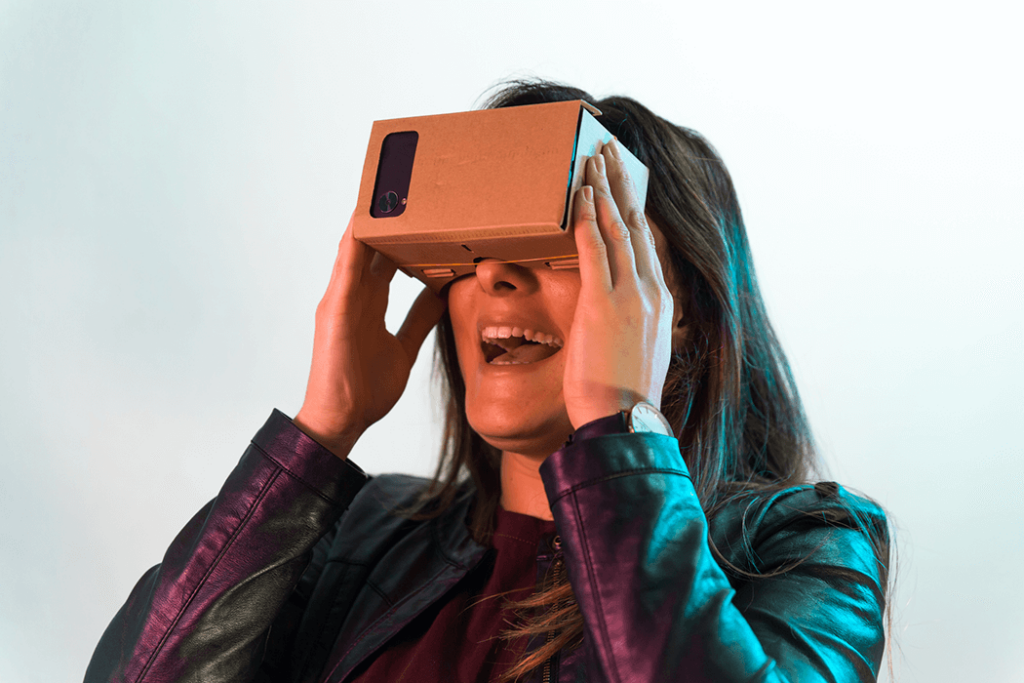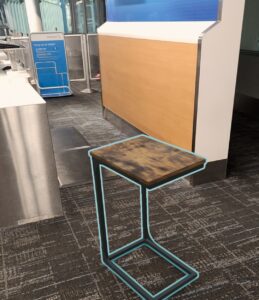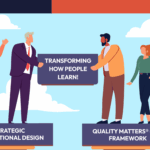Learning in Alternate Realities
Written by Dr. Diana Brandon
Although AI has replaced VR and AR as the primary acronym in education and training, this doesn’t mean that VR and AR are any less valuable as teaching and training tools. Both virtual reality (VR) and augmented reality (AR) continue to be important in training and everyday life. For someone unfamiliar with AR and VR, it may seem daunting to consider. They are quite different from traditional instruction and literally change how learners interact with content and the world. So, what’s the difference? Before we compare the two, it’s important to understand what AR and VR are and their distinct characteristics.
Virtual Reality
Virtual reality (VR) is a digital environment that immerses users in a completely virtual world. It is often experienced through a headset, which blocks out the visual and sometimes auditory input from the real world, replacing it with a digital experience. This virtual environment can simulate the real world or create entirely fantastical realms. An inexpensive way to experience VR environments with your own device is by using cardboard goggles to hold your smartphone.

Platforms like YouTube offer 3D videos, such as those from National Geographic, providing a basic VR experience. Adapting your phone screen to be compatible with binocular vision, whether by holding it or using a headset, changes what is shown on the screen, similar to how shifting your head in the physical world alters your visual perspective.
Augmented Reality
 Augmented reality merges digital information with the user’s actual environment in real-time. AR is all about enhancing the real world by adding extra information or features. These experiences are becoming increasingly popular since they are cheaper to implement than virtual reality.
Augmented reality merges digital information with the user’s actual environment in real-time. AR is all about enhancing the real world by adding extra information or features. These experiences are becoming increasingly popular since they are cheaper to implement than virtual reality.
Have you ever used “See it in your space” while shopping online? Amazon and Wayfair offer this feature, allowing you to place furniture or artwork in your space using your phone screen. They use this feature to help consumers visualize potential purchases. Have you ever played games with digital prizes in your real environment, such as Pokémon GO? Have you ever walked through an immersive artistic masterpiece like the Van Gogh Experience?
If you have, then you’ve experienced augmented reality.
Learning New Realities
These technologies sound exciting, but what do they have to do with training and education? Quite a bit. Both AR and VR have found their way into corporate, K-12, and professional settings, with each tool offering certain advantages.
- Engagement
Both AR and VR enhance learners’ engagement. VR’s immersive experience and AR’s duality offer learners a new and ever-evolving experience. AR can make learning materials more interactive and engaging by overlaying digital information onto textbooks, classroom materials, or even the real-world environment. This can transform a traditional lesson into an interactive experience, making learning more engaging and enjoyable. As we’ve discussed, VR gives a fully immersive experience, particularly valuable for scenario-based learning. - Available Learning
Since AR can be experienced through smartphones and tablets, it offers a readily available way for students to engage with educational content. This access ensures that learning can extend beyond the classroom and be personalized to each student’s pace and style. Virtual field trips are more cost-effective and allow students to explore independently. The lower cost of AR and the devices’ flexibility allow more people to engage with the technology. - Immersive Learning Experiences
VR’s strength lies in its ability to create fully immersive learning environments. This can be particularly beneficial in history or geography lessons, where students can virtually visit historical sites or geographical locations, providing a deeper understanding of the subject matter. Many therapies and medical treatments use virtual reality for patients with injuries. The 2009 film Avatar featured futuristic virtual reality that blurred lines between two worlds. Jake, an injured soldier, is fully immersed in the world of Pandora through virtual reality. - Safe Simulation of Dangerous Situations
VR can simulate dangerous or inaccessible environments for training. For example, medical students can perform virtual surgeries, or engineering students can experience hazardous industrial environments without real-world risks. VR is also valuable for law enforcement training, where split-second decisions have life-and-death consequences. Virtual reality synthetically creates different scenarios’ look, feel, and movement, allowing learners to evaluate the full environment rather than reading about selected details in a case study. - Enhanced Concentration
The immersive nature of VR can help minimize distractions, allowing students to focus entirely on the subject matter. This increased concentration can lead to better information retention and a deeper understanding of the topic. A 2023 meta-analysis by Corrigan, Păsărelu, and Voinescu found positive global cognitive functioning, attention, and memory results from VR-based interventions. This study suggests that VR-based learning could be even more valuable for those who struggle with traditional learning modalities.
Potential Stumbling Blocks
Before investing in 360-degree video or purchasing headsets for your next in-person training, it’s important to acknowledge the limitations of both VR and AR.
- Accessibility
Accessibility is a mixed environment for AR and VR environments. AR and VR are primarily visual platforms, which indicates that they could be limited; however, there are endless opportunities for those with hearing and visual impairments to engage with the environments, a positive characteristic (Herskovitz, et. al., 2020). The specific platform used substantially affects how accessible these new realities are. Additionally, VR offers unique opportunities for those with mobility challenges. WalkinVR specializes in this type of adaptation for VR games. - Cost
In addition to the accessibility based on senses required for use, there is also the question of cost as a point of access. AR is functional through smartphones and tablets,, making it a more feasible option for widespread educational use. This allows bring-your-own-device institutions or those with one-to-one programs to implement AR options immediately without large hardware costs. While offering more immersive experiences, VR requires specialized equipment like VR headsets, which may not be readily available in all educational settings. Further, the quality of these headsets varies greatly. There is also a much higher cost to create custom VR content than AR when platforms don’t have the necessary content. - Effectiveness
Like any tool, AR and VR have immense potential. However, like any tool, they are only effective when used correctly and well. Using either tool to the greatest pedagogical and andragogical uses requires a thorough understanding of the audience and the objectives. The flash and novelty of both kinds of platforms can engage quickly, but without well-designed instruction to accompany the use of the tool, it becomes a very expensive form of entertainment with little learning value.
Ready to Launch–Maybe
Both AR and VR technologies offer exciting possibilities for training and education. Selecting whether or not to include one of these tools in your next training depends on many different factors: your target audience, your learning objectives, your content, and your budget.
If you’re interested in evaluating or implementing AR or VR training, we can help. At eLearningDOC, we can help you analyze all the factors for your particular training and determine if either technology is a tool you could or should employ. Contact the DOC today to chat about your goals and let us help you navigate all the possible training realities you’re facing.
Watch our July webinar featuring Farah Allen, CEO & Founder of the Labz, as she discusses both AR & VR technologies.
Sources
Corrigan N, Păsărelu CR, Voinescu A. Immersive virtual reality for improving cognitive deficits in children with ADHD: a systematic review and meta-analysis. Virtual Real. 2023 Feb 18:1-20. Doi: 10.1007/s10055-023-00768-1. Epub ahead of print. PMID: 36845650; PMCID: PMC9938513.
Herskovitz, J., Wu, J., White, S., Pavel, A., Reyes, G., Guo, A., and Bigham, J.P. 2020. Making Mobile Augmented Reality Applications Accessible. The 22nd International ACM SIGACCESS Conference on Computers and Accessibility (ASSETS ’20), October 26–28, 2020, Virtual Event, Greece. ACM, New York, NY, USA, 14 pages. https://doi. org/10.1145/3373625.3417006








